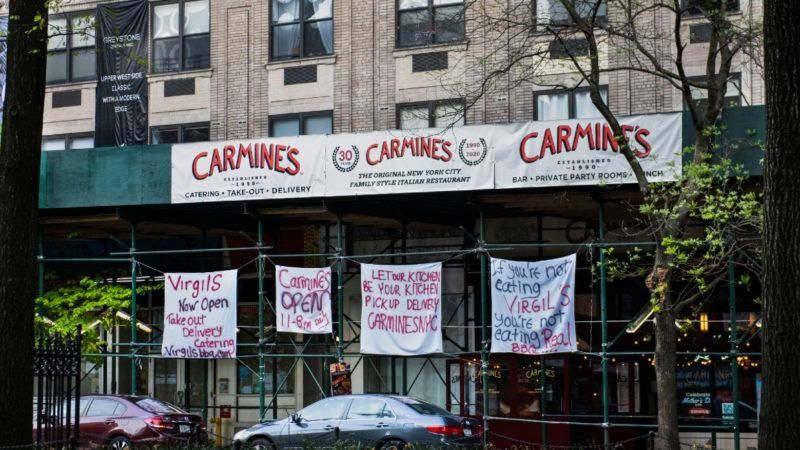Ghost Kitchens Can Help Feed New Yorkers While the City Is a Ghost Town
Regulations are making it harder for restaurants in NYC to adapt to COVID-19.

During the restaurant boom of the 2010s, blue states and cities loaded unfunded mandates onto eateries. (In New York City, the government website lists approximately 32 different state and city permits, registrations, and mandates.) Then COVID-19 shut down an estimated 40 percent of restaurants nationwide. The industry suddenly faced sales losses of $80 billion, and two-thirds of its employees across the country were thrown out of work. The regulatory load only increases the likelihood that a restaurant will stay closed and cooks or waiters will lose their jobs permanently.
Some employees might not get their jobs back even if the restaurant reopens. Rising costs could push more places to remake themselves as ghost kitchens—places that cook solely for delivery with no in-house seating.
Restaurants are high-risk and low-margin. About 20 percent fail in their first year, 60 percent by year five. Profit margins range from 1 to 10 percent. The typical restaurant can't survive more than a few weeks without profit. Even before COVID-19, full-service restaurants were losing market share to lower-service formats, which increasingly replaced servers with touchscreen and app-based ordering. As of last year, the market research consultant NPD reports, carry-out, drive-through, and delivery sales accounted for 48 percent of restaurant revenues.
New York City, with its long working hours and commutes, has long been a robust take-out and delivery market. In such high-cost cities, ghost kitchens were already on the rise. This business model eliminates the need for expensive street frontage and lets the cooks offer multiple cuisines from a single kitchen. While a typical restaurant spends 30 percent of revenue on labor, a ghost kitchen spends only 10 percent.
COVID-19 is likely to accelerate the trend—especially coming on the heels of higher regulatory compliance costs. Thirty-three jurisdictions (states, counties, and cities) will require at least a $15 minimum wage by the end of 2020 (with some lower minimums for tipped employees). Seven states have mini-Worker Adjustment and Retraining Notification Act (WARN) Acts (requiring at least 60 days' notice to employees before a place of business is shut down) more stringent than the federal requirement. Predictive scheduling laws require employers in seven jurisdictions to give up to two weeks' notice of schedule changes. Eight states (plus the District of Columbia) have paid family leave. Thirty-three jurisdictions have paid sick leave. And new laws in 10 jurisdictions require additional COVID-19 leave.
Seven jurisdictions are subject to at least five of those mandates. San Francisco and New York City are subject to all six. (San Francisco is slightly better off: California Gov. Gavin Newsom has partially and temporarily waived the state's mini-WARN Act.) In New York City, paid safe and sick leave extends to care for any individual whose close association with the employee is the equivalent of family; paid family leave extends to leave for unregistered domestic partners. With these open-ended, fact-intensive definitions, it will be too expensive for employers to contest even doubtful claims for leave. The Wall Street Journal reports that some lawyers were advising New York City restaurants to fire all their employees before they became liable under the new leave requirements.
Even apart from mandates, reopening restaurants will face pressure on their slender profit margins. The National Restaurant Association's COVID-19 reopening guidelines will require revamped operations, including radically reduced seating capacity (50 or even 25 percent), sanitizing schedules (which will limit the number of turns per table), employee health monitoring, and investments in contactless technology. Many restaurateurs anticipate plexiglass sneeze guards for coffee bars and employee protective gear.
Between those necessary changes and the inevitable pandemic-era decline in dining out, COVID-19 was already guaranteed to cripple the industry. Restaurants and the people who work there shouldn't have to deal with high regulatory compliance costs too. If officials don't ease the burden, a lot of these businesses will die—or will persist only as ghosts.

Show Comments (21)